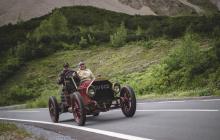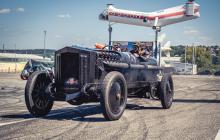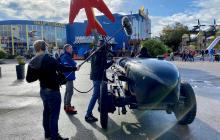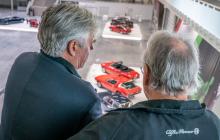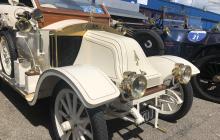Daytona 1911 – a low, short and slim streamliner was standing at the beach, ready for its speed record ride. Two mechanics were starting the huge vehicle. The engine had 21.4 litres of displacement and reached 200 hp at 1,650 revolutions/minute. The driver, Wild Bob Burman, readjusted his dust goggles before “warming up the sand a little,” how he tenderly called it. Then, the vehicle went down in history: the Blitzen Benz reached a maximum speed of 228.1 km/h. Until 1921, this was the new world record. Aircrafts were only half as fast. The only human-made piece of metal exceeding that speed was a revolver bullet.
Even today, the Daytona myth continues to have an effect. Looking at it today, without front brakes with bead tyres and an open chain drive, the vehicle sends a shiver down your spine. Thanks to the enthusiasm of Bill Evans, who arduously rebuilt the vehicle that is so popular in the US, the Blitzen Benz is back alive. Bill Evans is a member of our museum. The Benz has been at the museum quite often in the past ten years, whenever appearances in Europe were scheduled.
Using the vehicle with its streamline bodywork nowadays turns out to be quite unfavourable. It had been constructed in order to start the Benz and warm it up before it was brought right to the race track. However, there was another variation of the Benz for hill climbs. In that version, the Benz had a conventional bodywork with a big cooler surface and was driven to the races on its own wheels. In order to reach the maximum speed, you needed a sprocket with 34 cogs in the front. It is the same as with racing bikes, the smaller the sprocket in the front, the more power you can generate from beneath but the lower the possible maximum speed. For the hill climb in Gallion for example, 24 cogs were installed. In this very remarkable and pretty steep hill climb, the Benz reached the finish line at 160 km/h. Back then, the men at Benz Mannheim were able to adjust the vehicle for the respective purpose within only a few days. Today, the streamline bodywork of the Blitzen Benz is exhibited at the Technik Museum Sinsheim next to the Blue Flame and takes the visitors back to old times.
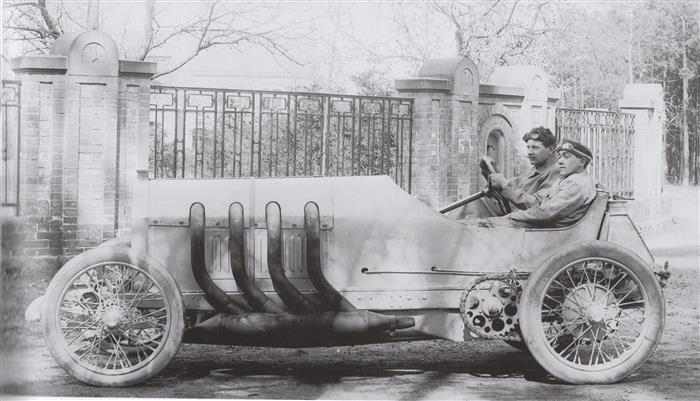
(This photo from 1911 shows Franz Heim from Mannheim and his co-driver before the start of the Ries Hill Climb in Austria. You can see the big chain ring for the road transport. People used to drive there on their vehicles’ own wheels. For the race, they installed a small sprocket. The vehicle won with a track record.)
(This is what the vehicle looked like before its restoration. The world record bodywork is now exhibited at the Technik Museum Sinsheim.)
The vehicle had been completely disassembled and rebuilt from scratch in order to reach the highest performance. During the restoration, one difficulty was to think back to the way of thinking in 1909. The solutions the engineers came up with back then, when they developed the Blitzen Benz on the basis of the Grand Prix Benz in 1908, were impressive. Lightweight construction was the top priority. The vehicle was supposed to have a maximum weight of 1,200 kg without the water, oil, petrol and tyres. The exhaust valves are 10.3 cm big. The vehicle has a 185-millimetre bore and a 200-millimetre piston stroke. It is almost a square design so that the engine can tolerate the rotation speed better. The restoration was done with help from Germany as well as England and the US. In the beginning of April 2019, we finally proudly presented the vehicle in Goodwood, England, at the Members Meeting. The Goodwood Members Meeting is a circuit race. Our member Ben Collings, who knows the circuit very well, drove the vehicle at the race. The Benz was the star of the event. Also, it was the fastest vehicle from before the First World War to cross the finish line. Ben Collings proved to have strong nerves when carefully operating the original leather cone clutch at the start. We thereby lost 150 m to the top but we were able to catch up soon enough. The result was an amazing third place which was highly respected by collectors worldwide.
We are still continuing to run the vehicle in thoroughly. Back home in Germany, its first presentation will take place at the BRAZZELTAG. Over 100 people took part in the latest restoration of the vehicle. Some of them will participate in the BRAZZELTAG. At the BRAZZELTAG, the vehicle will be duly presented, however, the BRAZZELTAG is a demonstration event, not a race. The next opportunity to see the vehicle in action will be at the Festival of Speed in July 2019 in Goodwood. Having presented the world record Fiat at the BRAZZELTAG before, we are now looking forward to being able to present the Benz from Mannheim as the star of the BRAZZELTAG.
However, the vehicle can also make you very lonely. There are not a lot of people who would consider sitting in the car as a passenger. Plus, it does not have an electric starter, it has to be started manually – but careful: if it goes wrong, you might break your bones.
The stories and reports represent the opinions and perspectives of the respective authors. Please note, especially while reading articles about our events, that binding information (e.g. opening hours, admission fees and programme) is only published on the museum's official website www.technik-museum.de.
Please note that the pictures, texts and videos published here are subject to the copyright of the respective authors and / or the museum and may not be used without permission.
Keep up-to-date with new articles
We recommend to subscribe to the museum’s newsletter via e-mail. At the end of each newsletter, we inform you about new articles so that you will not miss any of them. Alternatively, you can subscribe to an RSS feed:
Subscribe to newsletter RSS-Feed (Reader required)


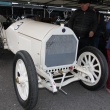
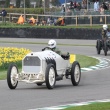
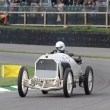
.JPG)


